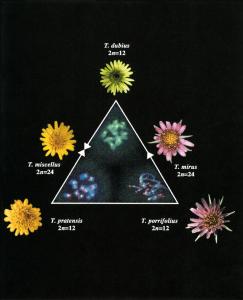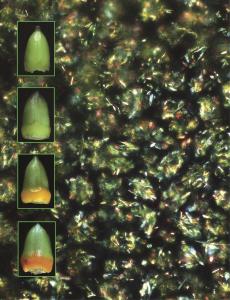abot91-7


Over 50 years ago, Ownbey published the discovery of the newly formed allotetraploids of Tragopogon. Color photographs of these plants and their diploid parents and hybrids formed an historical color plate in the American Journal of Botany. Tragopogon continues to serve as a model for recent allopolyploidy, as shown on this cover and characterized by Pires et al. using molecular cytogenetics in this issue. The triangle indicates parentage and reciprocal origins of tetraploid species of Tragopogon from their diploid progenitors in North America. Arrows indicate diploid(s) contributing plastids to the tetraploids. Fluorescent in situ hybridization of centromeric (green) and subtelomeric (red) repetitive elements are shown on metaphase chromosomes of the diploid species.
abot94-1


Model systems such as the single, large nectary embedded in the basal wall of the gynoecium (insets on left, c. 203) of tobacco (Nicotiana langsdorffii x N. sanderae Hort. Var Sutton's Scarlet) are contributing to our understanding of the cellular and molecular processes leading to the secretion of nectar, a complex mixture of compounds, near the time of anthesis. Nectary development from inception through maturity involves a number of highly integrated processes to form sugary nectar and compounds such as hydrogen peroxide and antioxidants such as b-carotene and ascorbic acid, which protect the nectar and nectary from microbial activity and auto-oxidation. Horner et al. focused on the production of b-carotene in nectary plastids as the organelles, which are filled with starch early in development, convert to being filled with b-carotene at maturity. The upper three insets show gynoecia at earlier, successive stages of development when their basal nectaries are lime green to green-orange and plastids are filling with starch and increasing in carotenoid content. In the bright orange nectary at maturity (anthesis) (bottom inset), almost all the plastid starch has been converted to sugars, bcarotene, and ascorbic acid. The background image (c. 3400) shows with polarizing optics the internal nectary tissue at anthesis, when the plastids are engorged with needle-like b-carotene crystals. The study helps elucidate the different processes associated with nectar production so that they may be manipulated to enhance the quantity and quality of nectar for attracting insects to enhance cross pollination and hybridization among crop and horticultural plants.